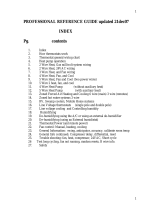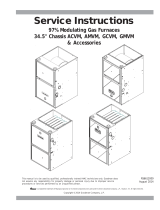
I
Honeywe
I
I
Heating,
Air
Conditioning or
Heating/Air Conditioning
Thermostats
INSTALLATION INSTRUCTIONS
The CT50A
is
for most gas and
oil
heating-only systems.
The CTSOC is
for
most electric
air
condmoning-only systems.
The CTSlA is
for
most
gas,
oil,
or electric
healing/electric air conditioning systems
The CT53A
is
for
millivoltage heating systems.
Do-it-yourself
models
CT5OA,C; CT51A; CT53A
CPfilA
shown
YOUR
NEW
THERMOSTAT
Your new Honeywell CT50A
Heating Thermostat will replace
most 15 to 30
V,
2-wire heating
system thermostats. The CT50A
is suitable only
for
gas or oil
heating systems (NOT
for
air
conditioning, heating/air
conditioning, heat pump or
electric heating systems).
Your new CT5OC Cooling
Thermostat will replace most
15
to
30
V,
3-wire air conditioning
system thermostats (NOT
for
heating, heating/air conditioning
or heat pump systems).
Your new CT51 A
Heating/Cooling Thermostat will
replace most
15
to
30
V,
4-wire.
heating/ cooling system
thermostats. The CT51A is
suitable
for
gas, oil
or
electric
heating/electric air conditioning
systems (NOT for heat pumps).
Your new CT53A Heating
Thermostat is suitable
for
250,
500
or
750
millivolt
(mV)
heating
systems only.
PREPAI
REMOL
WIRE
A
TROUB
Proper installation
of
your
new thermostat will occur
if you follow instructions STEP-
BY-STEP.
It
is recommended
that as you read, understand and
complete each step, you check
it
off
with pencil
or
pen.
Check thermostat
suitability lor
your
home’s
system by reviewing
YOUR
NEW
If
you are unsure about wiring
procedures, please call a
qualified service technician for
assistance. THERMOSTAT section, above.
FLAT
BLADE
SCREWDRIVER
HAND
OR
POWER
DRILL
WITH
3/16
INCH
DRILL
BIT
WIRE
CUTTER/STRIPPER
OR
SHARP
KNIFE
SPIRIT
LEVEL
OR
PLUMB
BOB
AND
LINE
11.95%
and discard the
under the cover.
Save package
of
screws
and instruction pages.
anticipator adjustment
Disconnect wires
from old thermostat or
subbase.
If
your thermostat
has more than
2
wires, as
you disconnect each wire,
tape the end and label it with
the letter of the terminal
designation to make
reconnection to new
thermostat easier. Take care
that these wires do not fall
back into the wall opening.
Keep the old
thermostat
for
reference purposes until
your new thermostat is
functioning smoothly.
WiRE
AND
MOUNT
For
CTSOA:
Connect each
rom the wall
to
either terminai on the
back
of
the thermostat.
Tighten
the
screws.
For CT50C
or
Cf51
A:
Connect wires
from the wall to matching terminals on back of thermostat.
Tighten the screws.
NOTE:
If
terminal designations on old thermostat do not match
those on new thermostat, refer
to
chart below.
system, and callnot

Printed
I
REMOVING
OLD
THERMOSTAT
If
you have an
electric furnace. you
need
to
determine how your
fan is controlled Turn it on
and adjust your present
thermostat
so
the heat
comes on, while observing
when the fan comes on If the fan comes
on immediately you need
to
add the
jumper noted in section
4
between
terminals 1
&
2
If
there is a noticeable
delay before the fan comes on, there
IS
no need
to
add the jumper because your
furnace controls the fan
0
heating/air conditioning system at
the main fuse panel
Most
residential
systems have a separate switch box or
circuit breaker for disconnecting power
to
the furnace
Remove cover of old thermostat-
0
cover normally snaps off when
pulled firmly from the bottom If it resists.
check for
a
screw that locks the cover on
0
before removing the old
thermostat from the wall, look at
it
carefully
to
locate ihe heat
Begin by turning off power
to
the
-
For CT50A or CTSIA installation

4
WIRE
AND
MOUW
.THERMOSTAT
wntinued)
Recheck for level positioning, and firmly
tighten both mounting screws
If
installing CTSOAor CT51 A, makssure
CI you Aave the
turf-
{anticipator setting)
for your system. This is the number you wrote
in
the box in step
3
If
you were unable
to
find the
current draw for step
3.
this information can be
found printed on the primary control at the
furnace. The primary control
is
usually
a
gas
valve,
zone
valve, or a retay
or
burner
control
box
with the thermostat wires connected to it. For
electric heat, you need to add the
:.
n relay
current, usually
0
2
to
0.4
A.
ZONE VALVE
OIL
BURNER
CONTROL
SHOWS
CURRENT DRAW
s
LOW
AGE
TO
BURNER
NT
DRAVI
TYPICAL GAS VALVE
ii.iaic
On the CT50A or CT51A, set heat
anticipator indicator at rating printed on
primary control.
Adjuslablt,
Hea'
Ari
c
Set;[.
I
1-
Press the thermostat cover firmly onto the
0
mounting clips
CHECK
OUT
THE
THERMOSTAT
To prevent possible com-
pressor damage, do not
operate air conditioning
if
outdoor temperature is
below
50"
F
[lo0
C]. Once
the air conditioner is
off,
do not turn
it
on
for 5
minutes: this action will
prevent compressor
damage.
On
the CT51A, the system
switch controls as follows
HEAT-heating system only
operates.
OFF-heating and air condi-
tioning systems are dis-
connected
COOL-air conditioning sys-
tem only operates.
The fan switch controls as
follows:
AUTO-fan operates when
heating or air conditioning
system operates
WL
I
ON-fa rates co
ousl
NOTE In the following instruc-
tion, disregard heating or air
applicable
to
your syst
heating/air conditioning
system
Observe system operation
for at feast one cycle
on
both heating and air conditioning.
To observe.
Place the system switch
0
at HEAT position and fan
switch at AUTO. Move the temper-
ature setting laver
10"
F
[So
C]
above room temperature. The
heating equipment should turn
on
A
short warm-up period may
be required before the system
fan turns on.
Place system switch at
0
COOL position and move
temperature setting lever 10"
F
[So
C] below room temperature.
The arr conditioning equipment
should turn on and the system
fan should turn on.
NOTE Some systems have a time
delay that can prevent opera-
tion up to
5
minutes.
Turn the fan switch
to
ON.
0
The system fan should turn
on, and operate continuously.
The system blower should con-
tinue
to
operate at any system
switch or thermostat setting.
{MOSTAT
'ING
On CTSlA, place the sys-
tem and fan switches at
the desired settings for operation.
On all models, move the
temperature setting lever
to the desired temperature com-
fort level

I
I
TROUBLESHOOTING
Your Honeywell thermostat requires little
or
no attention. Most problems can generally
be
traced to
the
following:
NOTE:
If
your system is heating-only or air conditioning-only, disregard sections not applicable to your system.
SYMPTOM
No
heat
-_____
Furnace turns on
and
off.
Major swings in
^_^^_^
1..
..^
PROBLEM
System switch at
OFF
or
COOL
Position.
Blown fuse or tripped
circuit breaker
Furnace power switch
is
on
QFF.
No pilot flame
Improper connections to
thermostat.
Defective thermostat.
(Here’s how you tell:
Remove the thermostat
from the wall. Discon-
nect wire from
W
ter-
minal. Touch
W
wire to
R
terminal. The thermo-
stat is detective
if
the
burner comes on.)
Other.
Burner
ON
period is too
short,
Burner
ON
period
:-
*^^
,---
SYMPTOM
Move switch to HEAT Thermostat setting
position. and thermometer
reading disagree.
Replace fuse or reset
circuit breaker
Switch to
ON
_._
_-
CORRECTI~E
Am
Relight pilot flame per
furnace manufacturer’s
instructions
With power to furnace
OFF,
tighten all mounting
and terminal screws. Re-
pair frayed or broken
wires.
Exchange the thermostat
(see Warranty). ing
No
air Condltlon-
Contact a qualified service
technician for assistance.
Remove the thermostat
cover and move the heat
anticipator lever COUNTER-
CLOCKWISE
n
one
scale mark. Replace the
cover and wait several
hours for the system to
stabilize.
Remove the thermostat
^^..^_
..-A
-^..^
A&.^
LA-.
PROBLEM
Thermostat is not level.
Thermostat affected by
drafts or radiant heat.
Thermostat is out of cali-
bration.
Thermometer is out of
calibration
System switch in in OFF
or HEAT position.
Blown fuse or tripped
circuit breaker
Compressor switch
(lo-
cated outdoors) is turned
OFF
Improper connections
to
thermostat
--
Defective thermostat.
(Here’s how you tell.
Remove the thermostat
from wall Disconnect
wire from
Y
terminal
Touch
Y
wire to terminal
R.
The thermostat is de-
fective
if
the compressor
CORRECTIVE ACTION
Recheck the thermostat
position on wall. Use a
bubble level to make sure
it’s
level. See step
4.
Contact a qualified service
technician to change the
location. The thermostat
should be about
5
ft
[1.5
m] above the floor and on
an inside
wall.
Contact a qualified service
technician to recalibrate
the thermostat.
Recalibrate. See step
8.
Move siitc-h to
cooi
position.
Replace fuse or reset
circuit breaker.
Move switch to ON posi-
tion.
With power to furnace
OFF,
tighten
all
mounting
and terminal screws. Re-
pair broken wires.
Exchange the thermostat.
See Warranty.
-
 1
1
-
 2
2
-
 3
3
-
 4
4
Honeywell CT50A User manual
- Category
- Thermostats
- Type
- User manual
Ask a question and I''ll find the answer in the document
Finding information in a document is now easier with AI
Related papers
-
Honeywell CT50A User manual
-
Honeywell CT1500 User manual
-
Honeywell CT1802 User manual
-
Honeywell T8600D User manual
-
Honeywell Round CT87B User manual
-
Honeywell Honeywell/20 CT2095 User manual
-
Honeywell CT3355A1003 User manual
-
Honeywell CT41A User manual
-
Honeywell T822C User manual
-
Honeywell Y460A2003 User manual
Other documents
-
 RiteTemp 6035 User guide
RiteTemp 6035 User guide
-
 GOODMAN GMVM971205DN User guide
GOODMAN GMVM971205DN User guide
-
Intertherm M5S User manual
-
Broan 04MD-140A-16-FA Installation guide
-
FIELD CONTROLS WML-C User manual
-
Broan M1SC 066 User manual
-
Nordyne M1SC 066 User manual
-
Nordyne M1SC 066 User manual
-
Broan M5S Installation guide
-
Broan RG1 Installation guide





